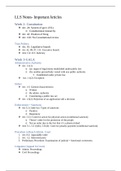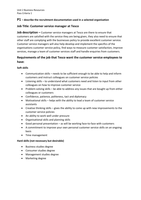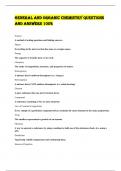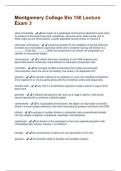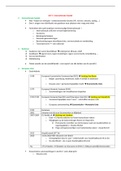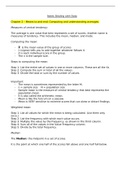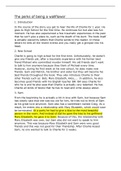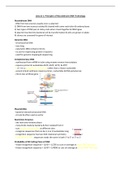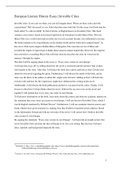Social Media at Work
Lecture 1
Work has changes over the years and so did communication
Gen Z:
- Faster in changing jobs
- Digital natives
- Communication style
- Less committed to single employer
There are differences, but it is mostly by age instead of generation
Changes in workplace because of COVID:
- Work from home
o Boundary management
- Virtual teamwork
o Social capital
- Leadership
o Management
o Transactional vs transformational leadership
Transactional: focus on supervision and group performance. Focus on
specific tasks and use rewards and punishment to motivate followers.
Strict management structure.
Transformational: inspiring others to follow, requires a high degree of
coordination, communication and cooperation. Use charisma and
enthusiasm for motivation.
- Social consequences:
o Loneliness, health and wellbeing
COVID-19 and the workplace: implications, issues, and insights for further research and action.
a) emergent changes in work practices (WFH, virtual teamwork and virtual management)
b) emergent changes for works (social distancing & loneliness, health & wellbeing, unemployment &
inequality)
c) the importance of moderating factors (demographics, individual differences, organizational norms)
Networked individualism:
- Early industrialized society (people bound up in groups) little boxes:
o Very local
o A few groups with clear boundaries
o Hierarchically and structured
o Social activity bounded by place and time
, o Dominant mode of communication is face-to-face
o You have 1 little box
- 1960-2000 technology comes into place glocalized networks
o People in different places and multiple social networks
o Psychological neighborhoods: communities based on common interest
o Social networks disembodied from place. However, place remains important as
the home and workplace are the bases place-to-place connectivity
o Dominant mode of communication is fixed telephone, mail, fax and the internet
o There are still little boxes but some networks are outside of them and you are
member of more than 1 little box. So you have multiple little boxes.
- 21th century networked individualism
o You will loose your little boxes, so no little boxes
o Person-to-person connectivity
o Rapid switching between networks
o Each person separately operates his network to obtain information, collaboration,
orders, support, sociability and a sense of belonging
o Interpersonal relationships increasingly based on specialized roles. We become
specialists just as Gen Z is an expert on social media.
o Weak ties become increasingly important because you need a lot of connections
and with weak ties you can switch more easily.
The network society and the networked organization:
- A form of cooperation in which all social processes in ALL domains of human activity
are increasingly organized in the form of networks, in which the nodes (a person) are
increasingly connected by ICT.
o Network = a set of interconnected nodes
o Flexibility and adaptability
o No middle man (managers)
o Without ICT it is difficult to mobilize resources and manage complexity in large
networks.
o Its about connecting people
o For example: different firms and departments work together on a project but
dissolve again afterwards
Lecture 2
Duality of technology:
- Technology structures
o It is used by humans to accomplish actions
o It recognized that technological features affect humans
- And is structured
o Is created and changed by human action
, o It recognizes human agency
Determinism: technology pushes change within organization. We invented the bike which made
us want to extent our network. Technology has an impact, takes no person in account in terms of
effects. Make technology, people adapt.
- Gives structure to thought and behavior
- Technology determines social change
o Technology is an autonomous force
o Technology is not natural
- Technology is the reason for growth and progress of a society
Determinism can be distinguished in two subcategories:
- Dystopian = moral panics: media as causal agents of bad things occurring in society, as a
threat to societal values.
- Utopian: media as causal agents of good things occurring in society, as the motor of
positive change. If we implement A, then all our problems will go away.
Limits determinism:
- Human agency has a big effect:
o People develop the technology
o Select an appropriate technology
o Use technology
o Adapt technology
- This is not taken into account
Constructivism: because of our needs, we invent technology. We want to extent our network
which made us think of and invent the bike. People and context determine technology’s meaning,
use and outcome. See a need, make technology.
- Technology is not an autonomous force
- Technology is neutral
- Technology is
o Written by inventors
o Interpreted by users
o Technology is structured by human thought and behavior
- Technology develops as a result of social, cultural or economic factors rather than being
the reason for social growth.
Limits:
- Technology relativism
o Technology is not neutral. You can’t make tea with a gun.
- Ignores role of technical characteristics
- Cannot explain similar uses and effects of same technology
, Sociomateriality is the linking pin between both. This is called constitutive entanglement:
humans and technology are intrinsically linked and influence each other. This is observable at
both a micro and a macro level.
Socialmateriality: It is the interplay between technology, organization/work and social.
Therefore, to understand social media, we need to understand that there is an interplay between
humans and technology.
What is social media:
- Broad definition:
o All mediated interaction
- Narrow definition:
o Many to many
Public / visible
Behaviors, knowledge, preferences and communication network is
now visible
Associations
o User-generated content
Editable or commentable
Crafting and recrafting communicative act before viewed by others
o Persistent
Remains accessible
Everything you say or share will stay on social media, but snapchat?
Persistence is important but sometimes not as important as other factors
o Association
Established connections between individuals
Social media revolves around you having a network of associations. You
need followers before you have interaction
Visibility features / examples for wiki, social networking sites (social media), blogs, social
tagging and microblogs:
Lecture 1
Work has changes over the years and so did communication
Gen Z:
- Faster in changing jobs
- Digital natives
- Communication style
- Less committed to single employer
There are differences, but it is mostly by age instead of generation
Changes in workplace because of COVID:
- Work from home
o Boundary management
- Virtual teamwork
o Social capital
- Leadership
o Management
o Transactional vs transformational leadership
Transactional: focus on supervision and group performance. Focus on
specific tasks and use rewards and punishment to motivate followers.
Strict management structure.
Transformational: inspiring others to follow, requires a high degree of
coordination, communication and cooperation. Use charisma and
enthusiasm for motivation.
- Social consequences:
o Loneliness, health and wellbeing
COVID-19 and the workplace: implications, issues, and insights for further research and action.
a) emergent changes in work practices (WFH, virtual teamwork and virtual management)
b) emergent changes for works (social distancing & loneliness, health & wellbeing, unemployment &
inequality)
c) the importance of moderating factors (demographics, individual differences, organizational norms)
Networked individualism:
- Early industrialized society (people bound up in groups) little boxes:
o Very local
o A few groups with clear boundaries
o Hierarchically and structured
o Social activity bounded by place and time
, o Dominant mode of communication is face-to-face
o You have 1 little box
- 1960-2000 technology comes into place glocalized networks
o People in different places and multiple social networks
o Psychological neighborhoods: communities based on common interest
o Social networks disembodied from place. However, place remains important as
the home and workplace are the bases place-to-place connectivity
o Dominant mode of communication is fixed telephone, mail, fax and the internet
o There are still little boxes but some networks are outside of them and you are
member of more than 1 little box. So you have multiple little boxes.
- 21th century networked individualism
o You will loose your little boxes, so no little boxes
o Person-to-person connectivity
o Rapid switching between networks
o Each person separately operates his network to obtain information, collaboration,
orders, support, sociability and a sense of belonging
o Interpersonal relationships increasingly based on specialized roles. We become
specialists just as Gen Z is an expert on social media.
o Weak ties become increasingly important because you need a lot of connections
and with weak ties you can switch more easily.
The network society and the networked organization:
- A form of cooperation in which all social processes in ALL domains of human activity
are increasingly organized in the form of networks, in which the nodes (a person) are
increasingly connected by ICT.
o Network = a set of interconnected nodes
o Flexibility and adaptability
o No middle man (managers)
o Without ICT it is difficult to mobilize resources and manage complexity in large
networks.
o Its about connecting people
o For example: different firms and departments work together on a project but
dissolve again afterwards
Lecture 2
Duality of technology:
- Technology structures
o It is used by humans to accomplish actions
o It recognized that technological features affect humans
- And is structured
o Is created and changed by human action
, o It recognizes human agency
Determinism: technology pushes change within organization. We invented the bike which made
us want to extent our network. Technology has an impact, takes no person in account in terms of
effects. Make technology, people adapt.
- Gives structure to thought and behavior
- Technology determines social change
o Technology is an autonomous force
o Technology is not natural
- Technology is the reason for growth and progress of a society
Determinism can be distinguished in two subcategories:
- Dystopian = moral panics: media as causal agents of bad things occurring in society, as a
threat to societal values.
- Utopian: media as causal agents of good things occurring in society, as the motor of
positive change. If we implement A, then all our problems will go away.
Limits determinism:
- Human agency has a big effect:
o People develop the technology
o Select an appropriate technology
o Use technology
o Adapt technology
- This is not taken into account
Constructivism: because of our needs, we invent technology. We want to extent our network
which made us think of and invent the bike. People and context determine technology’s meaning,
use and outcome. See a need, make technology.
- Technology is not an autonomous force
- Technology is neutral
- Technology is
o Written by inventors
o Interpreted by users
o Technology is structured by human thought and behavior
- Technology develops as a result of social, cultural or economic factors rather than being
the reason for social growth.
Limits:
- Technology relativism
o Technology is not neutral. You can’t make tea with a gun.
- Ignores role of technical characteristics
- Cannot explain similar uses and effects of same technology
, Sociomateriality is the linking pin between both. This is called constitutive entanglement:
humans and technology are intrinsically linked and influence each other. This is observable at
both a micro and a macro level.
Socialmateriality: It is the interplay between technology, organization/work and social.
Therefore, to understand social media, we need to understand that there is an interplay between
humans and technology.
What is social media:
- Broad definition:
o All mediated interaction
- Narrow definition:
o Many to many
Public / visible
Behaviors, knowledge, preferences and communication network is
now visible
Associations
o User-generated content
Editable or commentable
Crafting and recrafting communicative act before viewed by others
o Persistent
Remains accessible
Everything you say or share will stay on social media, but snapchat?
Persistence is important but sometimes not as important as other factors
o Association
Established connections between individuals
Social media revolves around you having a network of associations. You
need followers before you have interaction
Visibility features / examples for wiki, social networking sites (social media), blogs, social
tagging and microblogs:

